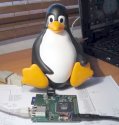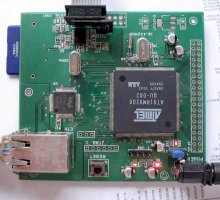First Colombian Linux SBC runs Debian
Apr 24, 2006 — by LinuxDevices Staff — from the LinuxDevices Archive — 140 views A graduate student in Colombia has developed a small ARM9 SBC (single-board computer) that runs Debian Linux. Carlos Camargo says he built his ECB_AT91 board for a doctoral research project in swarm robotics. He claims his design to be the first Linux-enabled SBC developed in Colombia.
A graduate student in Colombia has developed a small ARM9 SBC (single-board computer) that runs Debian Linux. Carlos Camargo says he built his ECB_AT91 board for a doctoral research project in swarm robotics. He claims his design to be the first Linux-enabled SBC developed in Colombia.
(Click for larger view of ECB_AT91 and Tux)
Camargo says he was inspired by similar SBCs created around Atmel's AT91RM9200 processor by Brazillians Darrell Harmon and Flavio Ribeiro.
Camargo notes that his PCB (printed circuit board) was designed in only two layers, while other AT91RM9200-based boards he knows of have four layers. Generally speaking, fewer layers saves manufacturing costs, while increasing the number of facilities able to make the PCB.
Camargo's ECB_AT91 board measures 3.3 x 3 inches (85 x 77). He apparently purchased a Tux-shaped case for the board, only to find that it did not quite fit. He has promised to make a follow-up version that does, however.


The ECB_AT91, top and bottom
(Click either to enlarge)
The ECB_AT91 is powered by an Atmel AT91RM9200 processor, which features an ARM9 core clocked at 180MHz. Other specifications include:
- Up to 64MB of SDRAM (supports 8MB/16MB/32MB/64MB)
- SD/MMC slot
- 2 MB of serial flash (DataFlash)
- 10/100 Intel Ethernet interface
- High speed USB 2.0 interface
- 4 SPI interfaces
- 2 serial (RS232) ports
- JTAG support
Booting Debian
Camargo says he succeeded in getting Debian Linux to run on his board, and he has published an interesting paper (PDF download) describing the process. He first used Harmon's loader and dataflash patch, both modified to suit his board's hardware addresses, to copy U-boot 1.1.2 and a Linux kernel to flash memory. The kernel was based on kernel.org 2.6.14 sources, patched for the Atmel processor, and built using GNU tools and Dan Kegel's Cross-toolchain. Camargo next used Debian's debootstrap program to download the ARM-Debian distribution, which he then copied to an SD card for use with the board.
Console output published in Camargo's paper suggests that he first gained a shell on Apr. 22, with a kernel listed as “ecb_at91 2.6.14 #19.”
“I hope that this work can be a starting point for Embedded Linux development in Colombia. My research group (Linux-enCaja) is open to any Linux fan or research group,” Camargo writes, in the introduction to his paper.
More details about Camargo's ECB_AT91 board can be found on his ECB_AT91 webpage.
This article was originally published on LinuxDevices.com and has been donated to the open source community by QuinStreet Inc. Please visit LinuxToday.com for up-to-date news and articles about Linux and open source.